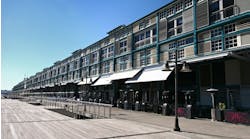As a facility manager, you’re responsible for keeping your building or even multiple facilities running smoothly around the clock. This requires oversight of the professionals who carry out cleaning, maintaining a sufficient supply of chemicals, tools and other supplies, replacing and repairing equipment and even dealing with unforeseen emergencies like leaks, alarms and more.
Now, infectious disease risks make maintaining safe and healthy environments even more paramount. With all eyes on cleanliness, facility managers are under an increasing level of pressure to tackle their toughest challenges with ease and within budget. Understanding best practices for dealing with these difficulties can be the difference between a good facility manager and a great one.
[Related: What is “Clean”? Industry Experts Respond]
Breaking Down 4 Barriers to Cleanliness
Whether you oversee an in-house team of cleaning professionals, outsource to a building service contractor or rely on a blend of both approaches, there are likely numerous cleaning-related challenges that you’ve faced as a facility manager.
Cleanliness goals can often feel at odds with your budget and schedule. However, being aware of these hurdles and how-tos for lessening their impact or likelihood of occurrence can keep your cleaning program and bottom line in better shape.
1. Consistency is lacking. Perhaps you’ve noticed that your daytime cleaners are managing cleanliness a bit better than your afternoon or night crew. Or maybe you’ve noticed a lack of consistency from one day to the next among the same team members. Either way, the solution to this problem is to revisit your training procedures to make sure that everyone understands what, how, where and when to clean.
Are employees relying on the correct tools and equipment to clean? Do they know how to properly use these supplies and machines? Demonstrations and hands-on training can help you sort out any incorrect habits that may have formed or shortcuts they’re taking.
Investing time in training provides immeasurable ROI because it ensures that cleaning is being carried out in the right way and gives employees a confidence boost and proof that their employer is investing in their success and growth.
2. New COVID-19 variants are emerging. It seems that every time we turn around, another COVID-19 variant is being discovered and we’re resigned to the fact that we’re living in a pandemic rather than getting through it. These variants can lead to localized outbreaks that put your building and those who occupy it at risk.
To keep the doors open, it’s important to follow a cleaning for health approach that carefully considers high-touch surfaces and areas. Clean and disinfect these the most frequently. Other lower-priority surfaces can be addressed with a cleaner and disinfected as needed.
Additionally, review your outbreak response plan so that you are prepared in the event that your staff members become sick or the building needs to temporarily close. With the right strategy, training, chemicals and tools in place, you will be prepared to reduce the spread of all types of pathogens.
3. Equipment is aging. From floor care scrubbers to vacuums to custodial carts, there are numerous types of equipment that cleaning teams regularly use. This equipment must be in good condition in order to clean effectively and efficiently. Keep a detailed log of the age of your equipment and the dates of service. Periodically inspect machines and other tools to ensure they are in good condition.
If aging equipment is not performing well, look into repairs and replacement to determine which option will provide the best results and ROI. When equipment is damaged, underperforming or difficult to operate, staff will become frustrated and may turn to alternative methods of cleaning that impact consistency and even safety. Make sure that staff have access to machines and tools that are durable, easy to use and reliable so that they don’t have to work harder by recleaning to make up for aging equipment.
4. Your team is understaffed. Throughout the pandemic, many organizations have encountered recruitment and retention issues and unfortunately, the cleaning industry is accustomed to facing high turnover rates. To attract great talent, fair wages and benefits are key, but you must also go beyond these financial drivers. Employees want to feel aligned with their employer on things like safety, sustainability and career development.
Invest in safe chemicals that don’t irritate skin or eyes or release volatile organic compounds that negatively impact indoor air quality. Moving away from toxic products with questionable ingredients is necessary, as professional cleaners use these solutions every day.
Select equipment that will enhance workplace safety, like floor scrubbers with high-quality squeegees to pick up excess liquid and reduce the risk of slips and falls. Wherever possible, aim to be more sustainable to showcase your commitment to protecting the planet.
Invest in regular training to not only ensure consistency, as mentioned previously, but to help employees reach their career goals and move up through your organization. Promoting your commitment to safety, sustainability and your people during the hiring process, onboarding and employee tenure can help you build and keep a great team.
[Related: How a Cultural Shift in Hotel Air Quality Will Keep People Safe]
Work Smarter, Not Harder
It’s an understatement that facility managers and their teams are working hard. The pandemic has led to an extensive overhaul for many commercial cleaning programs, requiring employees to adapt and learn new ways of cleaning and disinfecting. At the same time, organizations are struggling to recruit and retain cleaning professionals. Thus, it can often feel as if there aren’t enough hours in the day to address all of the priorities and the concerns of those who use these facilities.
While hard work is commendable, in order to limit burnout, lapses in cleanliness and the risk of injuries and illness, it’s important to find ways to work smarter. Working smarter can help cleaning teams avoid larger issues down the road that can derail their progress and wellbeing.
Being mindful of the top FM challenges and strategies for alleviating or overcoming them has many benefits. It can help increase confidence among those who work in or visit your facility, improve productivity and consistency, reduce costs, enhance your organization’s commitment to sustainability and more.
About the Author:
Kurt Kuempel is the vice president of GSF USA, a leading provider of cleaning services.



